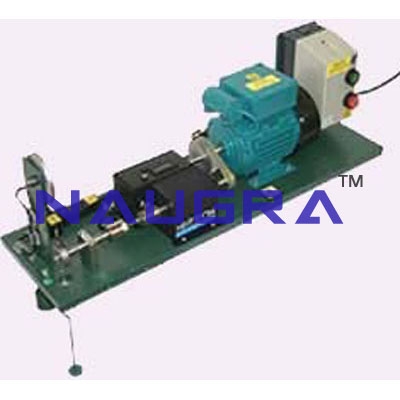- Civil Lab Mechanical Lab Engineering Lab Equipments
- sales@didacticlabequipments.com

CAT NO: DIDACTICNLE-Export-053018
Rotating Fatigue Machine Mk3- Engineering Lab Training Systems.
Features
Self contained
Bench mounted
Fully guarded
Digital readout of revolutions to failure
Motor stops when specimen fails
Necked specimens, steel, aluminium alloy
and brass
Ideal introduction to fatigue
Optional extra for alternating bending
fatigue
Three year warranty
Range of Experiments
To
make an introductory study of fatigue using a Wohler rotating fatigue
apparatus, including the time to failure caused by various stress levels
and materials
The accessory, HSM19X affords bending fatigue of
a cantilevered strip of metal or plastic in modes varying from
alternating to fluctuating stresses
Description
This
machine has been designed to introduce students to the effects of
fatigue. A simple cantilever specimen rotates at about 5700 or 1425
revs/min, inducing a sinusoidal variation of bending stress. At the
faster speed, a third of a million stress reversals occur each hour, so
failure should occur within a day. Failure can be hastened by using a
specimen with a stress raiser.
The loading system cancels its own
self weight enabling any desired value of bending stress to be applied,
ten mild steel specimens are supplied. Axiality has been ensured, and
care has been taken to reduce the effects of vibration. When failure
occurs, a microswitch stops the motor and the cycles to failure are
registered on a 5 digit revolution counter.
All rotating parts
are shielded and a safety guard is provided to restrain the broken
specimen. The apparatus is mounted on a heavy steel base plate and is
designed to overhang the bench or pedestal on which it is placed.
Ideally a heavy pedestal (eg concrete), isolated from the floor by
rubber matting, should be used to minimise shock loads.
An additional accessory for alternating bending fatigue and additional specimens are available.
This
equipment is part of a range designed to both demonstrate and
experimentally confirm basic engineering principles. Great care has been
given to each item so as to provide wide experimental scope without
unduly complicating or compromising the design. Each piece of apparatus
is self-contained and compact. Setting up time is minimal, and all
measurements are made with the simplest possible instrumentation, so
that the student involvement is purely with the engineering principles
being taught. A complete instruction manual is provided describing the
apparatus, its application, experimental procedure and typical test
results.
